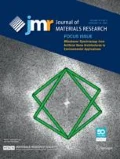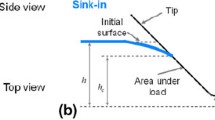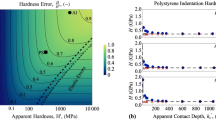Abstract
The phenomena of pile-up and sink-in associated with nanoindentation have been found to have large effects on the measurements of the indentation modulus and hardness of copper. Pile-up (or sink-in) leads to contact areas that are greater than (or less than) the cross-sectional area of the indenter at a given depth. These effects lead to errors in the absolute measurement of mechanical properties by nanoindentation. To account for these effects, a new method of indenter tip shape calibration has been developed; it is based on measurements of contact compliance as well as direct SEM observations and measurements of the areas of large indentations. Application of this calibration technique to strain-hardened (pile-up) and annealed (sink-in) copper leads to a unique tip shape calibration for the diamond indenter itself, as well as to a material parameter, a, which characterizes the extent of pile-up or sink-in. Thus the shape of the indenter tip and nature of the material response are separated in this calibration method. Using this approach, it is possible to make accurate absolute measurements of hardness and indentation modulus by nanoindentation.
Similar content being viewed by others
References
J. B. Pethica, R. Hutchings, and W. C. Oliver, Philos. Mag. A 48, 593 (1983).
S. I. Bulychev, V. P. Alekhin, M. K. Shorshorov, A. P. Ternovskii, and G. D. Shnyrev, Zavodskaya Laboratoriya 41, 1137 (1975).
S. I. Bulychev and V. P. Alekhin, Zavodskaya Laboratoriya 53, 76 (1987).
M. F. Doerner and W. D. Nix, J. Mater. Res. 1, 601 (1986).
M. F. Doerner, D. S. Gardner, and W. D. Nix, J. Mater. Res. 1, 845 (1986).
M. F. Doerner, Mechanical properties of metallic thin films on substrates using sub-micron indentation methods and thin film stress measurements techniques, Ph.D. Thesis, Stanford University (1987).
W. C. Oliver and G. M Pharr, J. Mater. Res. 7, 1564 (1992).
G. M. Pharr, W. C. Oliver, and F. R. Brotzen, J. Mater. Res. 7, 613 (1992).
G. M. Pharr and W. C. Oliver, MRS Bull. 17, 28 (1992).
J. J. Vlassak and W. D. Nix, J. Mech. Phys. Solids 42, 1223 (1994).
M. J. Mayo, R. W. Siegel, Y. X. Liao, and W. D. Nix, J. Mater. Res. 7, 973 (1992).
J. J. Vlassak and W. D. Nix, Philos. Mag. A 67, 1045 (1993).
S. P. Baker and W. D. Nix, J. Mater. Res. 9, 3131 (1994).
Author information
Authors and Affiliations
Rights and permissions
About this article
Cite this article
Mc Elhaney, K.W., Vlassak, J.J. & Nix, W.D. Determination of indenter tip geometry and indentation contact area for depth-sensing indentation experiments. Journal of Materials Research 13, 1300–1306 (1998). https://doi.org/10.1557/JMR.1998.0185
Received:
Accepted:
Published:
Issue Date:
DOI: https://doi.org/10.1557/JMR.1998.0185




